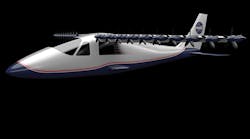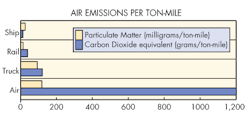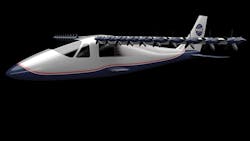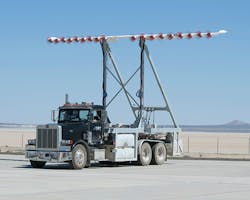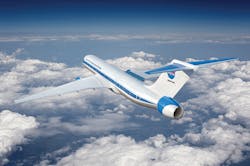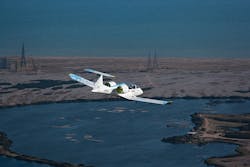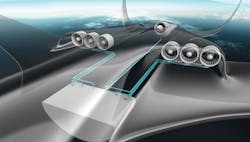This file type includes high-resolution graphics and schematics when applicable.
Part of the push toward electric-hybrid aircraft is to cut carbon emissions produced by aircraft. According to the Natural Resources Defense Council (NRDC), in 2012, 98% of all apparel items imported came from abroad and mostly through air transport. The NRDC reports that when a plane is used instead of a cargo ship, 4.5 times more particulate matter and 25 times more nitrous oxides are added to the environment. National Geographic reported in April 2015 that airplanes contributed 700 million metric tons of carbon dioxide to the air in 2013. The number, if changes do not occur, is set to triple by 2050.
The 1997 Kyoto Protocol climate pact delegated responsibility to the United Nations’ International Civil Aviation Organization (ICAO) for controlling aviation emissions. In the United States, many environmental groups have sued the Environmental Protection Agency (EPA) to push for harder regulations under the Clean Air Act. Last year, the New York Times reported that according to the EPA, American aircraft in the United States’ transportation sector contributed 11% of greenhouse gas emissions and 29% of all aircraft emissions worldwide.
Finally, this past February, ICAO announced the first-ever international agreement to cut carbon emissions from commercial airplanes. There are 23 countries onboard with the new agreement, including the United States. The agreement calls for a 4% reduction in fuel consumption from new commercial aircraft built after 2028 and from aircraft in current production that will be delivered after 2023. The new standards plan to cut carbon emissions from airplanes by more than 650 million tons between 2020 and 2040. According to a White House statement about the agreement, this is equivalent to emissions from 140 million cars. These regulations are driving the United States and other manufacturers to design more efficient aircraft.
NASA, Efficient Aircraft, and New X-Planes
The advancements of hybrid or electric power to improve automobiles serve as the base technology being applied toward aircraft. Currently, the engineers and scientists at NASA’s Glenn Research Center are actively researching the next generation of efficient aircraft. One of their current objectives is to help shift the industry from solely using gas turbines to start implementing hybrid or turboelectric propulsion. The benefits of this are reduced energy consumption, emissions, and noise.
Jim Heidmann, manager for NASA’s Advanced Air Transport Technology project, notes that “moving toward alternative systems requires creating new aircraft designs as well as propulsion systems that integrate battery technologies and electromagnetic machines like motors and generators with more efficient engines.” The researchers at Glenn are looking at alternate power systems that generate electricity in place or in addition to thrust at the turbine engine, and then the electricity is converted into thrust using fans at other aircraft locations. Along with this, they also are investing research into lightweight alternative materials, wire insulation, conductors, and the improvement of magnetic materials and semi-conductors to make motors and electronics lighter.
Sceptor, which stands for Scalable Convergent Electric Propulsion Technology Operations Research, is NASA’s distributed electric propulsion testbed. It is part of the next generation of X-planes and is the first step in NASA’s plan for a megawatt-class electric propulsion commercial aircraft. The goal is to create an aircraft that can fit nine passengers with a 500 kW power system (nearly 700 horsepower) by 2019. The plane weighs 3,000 pounds and is scheduled to fly in early 2018. The aircraft will have multiple electrically powered propellers evenly distributed on its leading edge to increase lift by up to five times at low speed and enables the use of a smaller and more efficient wing, optimized for cruising speeds. Joby Aviation has been working with NASA on Sceptor with its Leading Edge Asynchronous Propellers Technology (LEAPTech) program.
The LEAPTech program mounts 18 electrically powered propellers on its leading edge, which is then mounted above-truck. Initial tests have shown that distribution of power among the 18 motors has doubled the lift at lower speeds when compared to traditional systems (max speeds on the truck beds have been around 73 mph). With a wing aspect ratio of 17, the wing used for the LEAPTech program is very slender and does not have much room available inside for motors, controllers, wiring, and instrumentation. The area of the test wing is about half of the original P2006T wing.
The initial motor controller did not fit in the pod and was not fast enough, according to Starr Ginn, deputy aeronautics research director at NASA Armstrong Flight Research Center. “EMI created havoc on the communications bus. At high power, the whole prop system would turn off,” says Starr. Eventually, the motors and wing developed by Joby Aviation for LEAPTech will be used as NASA’s Hybrid Electric Integrated Systems Testbed (HEIST) and eventually the Sceptor test aircraft in 2018.
For the larger-scale aircraft, NASA is studying the Boeing 737-size hybrid turbo-electric powered airliner. Turbo-electric propulsion concepts create more efficient aircraft by combining turbine engines with generators that distribute power to electrically driven propulsors. Using the Boeing 737 aircraft size as the test platform allows NASA to introduce the advantages of a turbo-electric system while retaining the conventional tube-and-wing configuration.
The Starc-ABL (single-aisle turbo-electric aircraft with an aft boundary layer propulsor) is the new test proposal that builds upon previous N3-X team hybrid designs and Boeing’s concepts for turbo-electric airliners—research done under the joint Boeing-NASA venture the Sugar Program. The turbofans provide 80% of thrust during takeoff and 55% at the top-of-climb. The rest is done via the aft-fan propulsor located at the end of the aircraft below the tail. The aft-fan is designed to operate at a constant 3,500 horsepower at high throttle settings. Even with the additional weight from the empennage and larger wing compared to a similar-sized hybrid wing bodies, initial studies show a 15% improvement in thrust-specific fuel consumption at the start of the cruise.
According to NASA Langley Aeronautic Systems Analysis Branch engineer Jason Welstead, “this translates into 7% and 12% block fuel-burn savings for the economic and design missions, respectively.” By ingesting the slower-moving air coming off the fuselage body, the study proves the efficiency possible by the aft fuselage boundary layer ingestion fan, which achieves its benefit by ingesting up to 45% of the boundary layer. The electrically driven aft-fan provides the added benefit of suffering no thrust loss or power lapses that typically affect air-breathing engines at increased altitudes. Due to the increased efficiency of the propulsor, the diameter of the turbofans can be reduced from 70 in. to 52 in., helping the aircraft achieve an overall lower weight.
Airbus’ Hybrid Aircraft Concepts
Airbus set a new world record in July 2015 by being the first manufacturer to cross the English Channel using an entirely electrically operated aircraft. The E-Fan Electric Aircraft is a twin-engine electric plane with a maximum speed of 220 km/h that can run for 45 minutes to an hour on a single charge. E-Fan’s two electric motors deliver 60 kW of combined power, which drives the two aft-mounted, ducted, variable pitch fans. The lithium-ion battery system that powers the motors is comprised of 2,982 cells with a capacity of 2.8 amperes per hour each. The test aircraft that crossed the English Channel was a one-manned piloted aircraft that weighed around 600 kilograms at an altitude of 1,000 meters.
The E-Fan program is an expandable platform that leads to its Airbus larger program, the Distributed Electrical Aerospace Propulsion Project (DEAP Project). The program is part of Airbus’ E-Thrust Concept, which is being developed in conjunction with Rolls-Royce. The Airbus Group Innovations will take lead on the project, designing the electrical system and optimizing the integration of the propulsion system while Rolls-Royce develops an electrical system propulsion plant to build the new engines.
The E-Thrust concept involves a distributed propulsion system that has six electrically powered fans distributed along the wing span. There will be one centered gas-powered unit providing hybrid electrical power for the six fans and for recharging purposes. To achieve optimal propulsive efficiency, the bypass ratio values need to be beyond 12, which is the current value of today’s most efficient turbofans. Current estimations state that values of over 20 are achievable that leads to significant reductions in fuel consumption and lower emissions. The benefit of having a number of smaller e-powered fans as compared to larger electrical turbofans as seen in the Starc-ABL is reduced system noise.
The three essential parts of the DEAP architecture according to Airbus are: a wake re-energizing fan; structural stator vanes that supply electrical power and cryogenic coolant; and a hub-mounted superconducting electrical machine. Just as the concept behind the Starc-ABL, by ingesting the boundary layer and accelerating it by the fans, can cause a reduction in the losses in momentum that form a wake, lower drag, and increase efficiency, the DEAP system, with its relaxed engine-out design and better weight distribution, allows for greater flexibility over aircraft design leading to a smaller vertical tail plane. The stator section of the electric fans provides stator vanes that are aerodynamic and recover thrust from the swirling air.
The stator vanes also accommodate internal routing of superconducting cables to the hub-mounted superconducting electrical machine. Superconductivity is a quantum mechanical phenomenon where you have zero electrical resistance. This occurs in materials cooled below a critical temperature and allows electrical system components to be smaller and lighter. Cryogenic fluids like liquid hydrogen or liquid helium or a cryocooler—a technology used in many space applications—are used to achieve the desired effect.
The hub-mounted superconducting electrical machine drives the wake re-energizing fans. Rolls-Royce and Airbus Group Innovations, with Magnifye Ltd. and Cambridge University, are currently designing the Programmable Alternating-Current Superconducting Machine (PSAM). PSAM is a superconducting stator that will generate an electromagnetic field that rotates around the circumference at a velocity that is directly related to the frequency of the electricity supply. The electromagnetic torque is created by aligning the rotor’s magnetic field with the field electromagnetic field generated within the stator. The superconducting magnets used to generate the field are aligned in a puck form and can be programmed to deliver different controllable field strengths. This machine will eventually replace conventional copper and iron stator structures.
What Tech Improvements Are Still Required?
Lithium-ion batteries are the best choice for electrical hybrid systems (see “Small Batteries Deliver Big Power to UAVs”). However, higher-capacity batteries will be needed to hold and distribute the large power requirements required for these systems. Within the next two decades, energy densities will exceed 1,000 Wh/kg, according to Airbus, which will double our best performing batteries to date. The upcoming advancement in batteries is lithium-air batteries. They will have a higher energy density due to oxygen being a lighter cathode and a freely available resource. However, these batteries are still not yet commercially available.
NASA’s Sceptor design to Airbus’ E-Thrust concept cover the road map of aviation for the next five to 25 years. The ICAO hopes to curtail emissions by 2040 and the European Commission’s “Flightpath 2050–Europe’s Vision for Aviation” outlines a plan to accomplish their goals by 2050. By then, they hope—when compared to standards from 2000—to reduce CO2 emissions by 75%, nitrous oxides by 90%, and noise levels by 65%.
